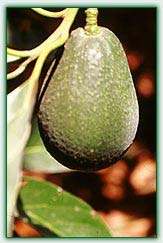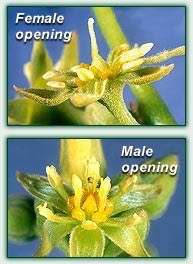Avocado (Persea Americana)
Flower biology
- The avocado flower is small, (up to 1 cm in diameter,) and perfect, having both male and female parts. The corolla includes 2 whorls of golden green petals. In addition there are 3 whorls of stamens and an inner whorl of heart-shaped orange stamenoids functioning as nectaries. The single pistil has an ovary, an elongated style and a stigma. Surrounding the pistil are 9 stamens. Each stamen carries an anther of 4 lobes that open by a cover that circles upward, exposing a clump of pollen grains. The flowers occur on terminal panicles. Approximately 1000 flowers open daily in each panicle, every day of the blooming season. A mature avocado tree may bear up to 1 million flowers in one season.
- Each avocado flower opens twice on two consecutive days. In the first opening, the flower is functionally female; no pollen is released but the stigma is white and receptive to pollen. The style stands erect from the centre of the flower; the corolla and the stamens lie at a right angle relative to the style. The nectaries are not active, but the stamenoids do secrete nectar. The flower then closes until the next day.
- At the second opening, the flower is functionally male; pollen is released and the stigma starts to dry up and turn brown. The three inner stamens hide the style and stigma. The remaining six stamens are inclined at a 60 degree angle relative to the style.
- Avocado cultivars are classified according to the time of the day they flower. Type A cultivars have female flowering in the morning of one day and male flowering in the afternoon of the next day. 'Haas' cultivar belongs to Type A group. Type B cultivars have female flowering in the afternoon of one day and male flowering in the morning of the next day. 'Etinger' and 'Fuerta' cultivars belong to Type B group. Due to the unique blossoming rhythm, a well-accepted practice is to interplant avocado orchards with varieties of opposite groups to promote cross-pollination.
- Inadequate pollination is known as the main limiting factor of fruit-set in avocadoes. Honeybees are apparently insufficient pollinators. They prefer the competing citrus bloom and wild flowers to the avocado flowers, thus limiting the fruit-set of early cultivars like 'Etinger' and 'Haas'. Furthermore, in the case of interplanted 'Etinger' and 'Haas' cultivars, the honeybees are ineffective in pollinating 'Haas' at a distance of more than a row or two from 'Etinger'. Since 'Haas' is highly dependent on cross-pollination, it represents another limiting factor on the yield of this variety.


Benefits
- The bumblebee has been proven 10 times more effective than the honeybee for within-cultivar pollination and 20 times more effective at pollination between cultivars. The foraging habits of the bumblebee differ from that of the honeybee. Whereas the honeybee foragers follow the signs of the "patrol" group of foragers for new/alternative sources of pollen and/or nectar, the bumblebee workers forage individually. Therefore, bumblebees from hives placed in the orchard are likely to visit the avocado bloom at a relatively higher rate than honeybees, especially when competitive bloom is present. An additional advantage of the bumblebees is that they are active at relatively low temperatures, on cloudy and rainy days, conditions typical of the intermediate season when the avocado blooms and in which the honeybees will not leave the hive.
- A field trial carried out in conventional orchards in Israel for 5 consecutive seasons showed that pollination of avocado with bumblebees added to honeybees, increased the yield of 'Etinger' cultivar by 24% and that of 'Haas' by 15% compared to honeybee pollination alone. In a bio-organic orchard a 51% increase in total yield was recorded for 'Haas'.
Introduction scheme
- The recommended introduction rate is 6-7 LARGE bumblebee hives per ha. In addition to honeybees at a minimal rate of 3-4 hives per ha.
- For 'Etinger' and 'Haas' interplanting, the bumblebee hives will be placed at three intervals: the first one at the start of 'Etinger' bloom (about 5% blossom), the second one at the peak of 'Etinger' bloom and the beginning of 'Haas' bloom, and the third one at the peak of 'Haas' bloom. This gradual introduction will ensure adequate pollination throughout the entire blooming period. Honeybee hives should be introduced simultaneously with the bumblebee hives.
Instructions for use
- Colonies should be placed on a sturdy support, about 50 cm above the ground; in spring in a sunny place, and later in the season in the shade.
- Secure the hive so that ants cannot enter it.
- After placement of the hive, let the bumble bees settle down for a while (½ - 1 hour) before opening the flight hole.
- Following their initial orientation flights the bumble bees will immediately start pollinating the crop.
- Bumble bees are active at temperatures between 10 and 30 degrees Celsius. They function best at temperatures between 15 and 25 degrees Celsius.
Crop protection
- Combining the use of bumble bees with natural enemies does not present any problems.
- Agricultural chemicals may have direct or indirect effects on the bumble bees. Direct effects occur when worker bees and larvae die as a result of contact with or digestion of a chemical product, indirect effects occur when the smell of the treated flower puts off the bumble bees, causing visits to stop.
- Systemic pesticides (pesticides that are absorbed through the roots) often have a long-lasting residual effect. If a flower produces nectar in addition to pollen (e.g. sweet pepper), the damage to the bumble bee population may be much more serious than in a crop that only produces pollen (e.g. tomato).
- You will find detailed information about persistence and compatibility of pesticides with bumblebees and most other beneficials in Zonda's Side Effects Guide or online at Koppert’s website: www.koppert.nl
- In all cases the BEEHOME option of the hive must be activated before the crop is treated. This option ensures that bumble bees can enter, but not leave the hive. After about an hour the hive can be closed completely, so that it can either be covered or removed from the crop.
- If the hive is temporarily removed from the crop, it should be stored at 18 to 20 degrees Celsius.
Need more help with our product?
Please call us on 0800 496 632